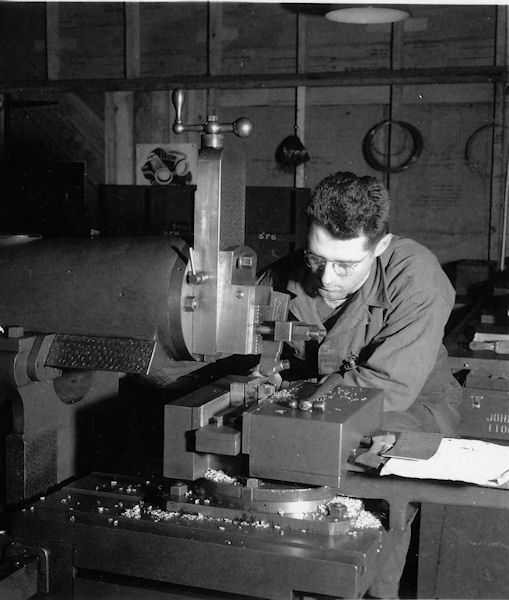

The 10th Station Complement Squadron (Sp) was activated at Jacksonville Army Air Field, Jacksonville, Florida on April 15, 1943 per paragraph 1, General Orders No. 32, Headquarters of the Third Air Force dated April 10, 1943. No personnel were assigned on the day of the activation.
The original enlisted cadre of six men were assigned from the Third Air Force Replacement Depot, Plant Park, Tampa, Florida on 18 April 1943 per paragraph 4, Special Orders No 42, Headquarters third Air Force Replacement Depot, dated April 18, 1943. The cadre consisted of 1/Sgt Clement N. Olson, S/Sgt Albert A. Bury, S/Sgt James H. Davidson, S/Sgt Marty Kapchuk, Sgt Robert H. Cranshaw and Cpl. Alvin R. Enlow.
Officers first assigned to the squadron were Major John H. Trossbach, Commanding; Captain Arthur W. Bledsoe, Executive Officer; 1/Lt Charles H. Steele, Adjutant; Captain Gene Cofield, S-3; 1/Lt Franklin W. Dawson, Asst S-3; 1/Lt Clark V. Britton, Supply Officer, 1/Lt Lloyd A. Bimson, Assistant Supply Officer; and 2/Lt Raymond E. Dell, Mess and Transportation Officer. These officers were assigned from Dale Mabry Field, Tallahassee, Florida per paragraph 5, Special Orders No. 105, Headquarters Dale Mabry Field dated April 15, 1943.
Subsequent orders relieved Major Trossbach as Commanding Officer and Captain Bledsoe was appointed Squadron Commander in his stead. This was on May 3, 1943. On May 14 Lieutenant Dawson was shifted from his duties as Assistant S-3 and appointed Squadron Adjutant vice Lieutenant Charles H. Steel, transferred to Kellogg Field, Michigan. Other changes in principal duties of the officers saw Lieutenant Erol R. Coleman, newly assigned, assume the duties of Mess and Transportation Officer, relieving Lieutenant Dell who was transferred to Dale Mabry Field. And Lieutenant Britton, Supply Officer transferred to Kellogg Field, was replaced by Lieutenant Bimson.
Also in May 1/Sgt Olson was replaced by 1/Sgt Emile Perez.
In the early weeks following activation the Squadron grew rapidly from its small cadre to a full strength of 108 enlisted men, these men being assigned from various Air Force installations throughout the United States. When all personnel passed field service physical examinations the Squadron embarked on a period of intensified field training. All officers and enlisted men went on a bivouac to Camp Blanding, Florida where two days were spent in qualification exercises with the caliber .30 rifle M-1903. At a later date when carbines and sub-machine guns had been issued the men fired familiarization courses at the nearby Jacksonville Rod and Gun Club range. All obtainable Unit equipment was crated and made ready for overseas shipment.
By the middle of May 1943, the Squadron had completes its activation and field training and was prepared for the next stage in its history-overseas movement.
Overseas Movement
At 0900 hours on 26 May 1943, the Squadron of 108 enlisted men and six officers entrained at Jacksonville, FL bound for Camp Kilmer, NJ, the staging area for overseas shipment. The train arrived at Camp Kilmer at 1030 hours on 27 May 1943. In the ten days' stay at the staging area all personnel records were examined and brought up to date, equipment shortages filled, Typhus immunizations given and a final shake-down inspection made.
At 1100 hours on 6 June the Squadron, now 106 enlisted men, departed from Camp Kilmer by Government Motor Transport to the Staten Island Terminal of the New York Port of Embarkation. The men boarded the S.S. Villa D'Anvers at 1530 hours. On the following morning the Villa D'Anvers backed away from the pier and headed through the Narrows out to sea where contact was made with a large convoy.
During the crossing the convoy was subjected to a three-day running attack by enemy submarines. No casualties were sustained. The transport docked at Swansea, Wales at approximately 2200 hours on 21 June and on the following morning the squadron debarked and boarded a troop train for Thetford, Norfolk, England. By motor convoy the squadron moved from Thetford station to Army Air force Station 115 at Shipdham, Norfolk.
Events Since Arrival in ETO
On 1 July 1943 the Squadron was divided into two detachments; Detachment "A" of forty enlisted men remaining at Station 115 and the other sixty men and officers moving to Station 118 at Wendling, England. At this station the Squadron made the field ready for the arrival of the 392nd Bomb Group and attached units which moved in on 2 August 1943. Shortly thereafter Detachment "A" was brought up from Shipdham and the Squadron reunited. The 10th SCS was on operation full strength for the first time in performance of the mission for which it was designed-operation of base utilities, flying control, transportation and similar auxiliary services.
In early December additional administrative, medical, transportation and mess personnel were assigned from the 74th Service Squadron and 317th Service Group. This brought the total strength of 218 enlisted men and 18 officers. The cadre for the new 74th Service Squadron, the original which had been converted into a Sub Depot Unit, came from the 10th Station Complement. Major Bledsoe (promoted from Captain in September) was relieved as squadron commander and Maj Elisha R. Daughtrey assumed command. Major Bledsoe was appointed Station Administrative Inspector. Lt Dawson was relieved as Squadron Adjutant and Lt Joseph R. Coppola appointed in his stead. Late in December Lt Dawson was appointed to the grade of Captain. 1/Sgt Condy E. Nichols became first sergeant of the squadron in place of 1/Sgt Emile Perez who transferred to the cadre of the 74th Service Squadron.
For heroism displayed at a bomber base in England…General Orders No. 17, HQ Eighth AF dated 20 Jan 1944 awarded to Sgt Lee A. Doolittle, Cpl. Richard A. Holevoet, Pfc Emil J. Ribar and Pfc William T. Sites, the SOLDIER'S MEDAL.
[Sgt Lee A. Doolittle was a member of the 392nd's crash crew, which was on standby every time planes took off or landed. When #42-7556 caught fire in the early morning of 5 December 1943, his crew quickly arrived with tankers, foam makers, and other gear. The heat was so intense, though, they had no chance of putting the fire out right away. Instead, their main objective was to keep the planes nearby from being damaged.
When an adjacent B-24 looked like it would catch fire, Doolittle took action. He boarded the a/c and worked to start the two inboard engines. He was soon joined by another man, and the two of them taxied the plane to a safe place in the weeds.
Another concern was to keep a small fuel dump, about 800 yards to the southeast, from catching fire. The threat was quite real, as the pump engine in a gas refueling truck parked about 300 yards from the plane was already on fire. While the crash crew was spraying foam onto the refueling truck, the bombs near #556 exploded. Even though Doolittle is 6 1/2 ft tall, the concussion from the blast blew him down into the mud. Shrapnel whizzed just above his head, putting big holes in the top of the gas refueling truck.
At the end of the long night, everyone in the crash crew was wet and muddy, but no one had been injured.
Cpl Richard A. Holevoet also fought the fire. Now deceased, he was a member of the base fire fighting platoon. He told family members that no one in his team was injured because they were so close to the fire that the flames went up and over them. He delighted in showing them a piece of shrapnel that he saved from that night. He also described the crater that remained after the explosions as "deep enough to throw a dead cow in."]
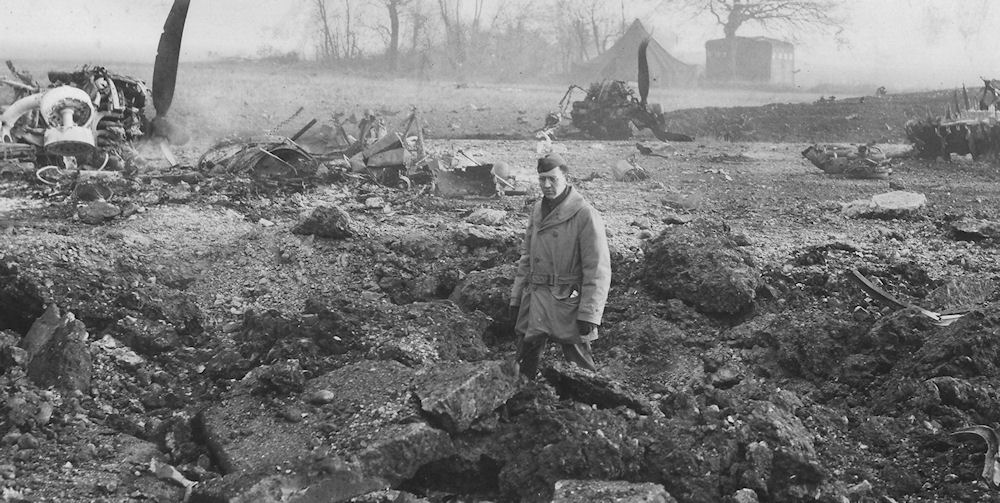
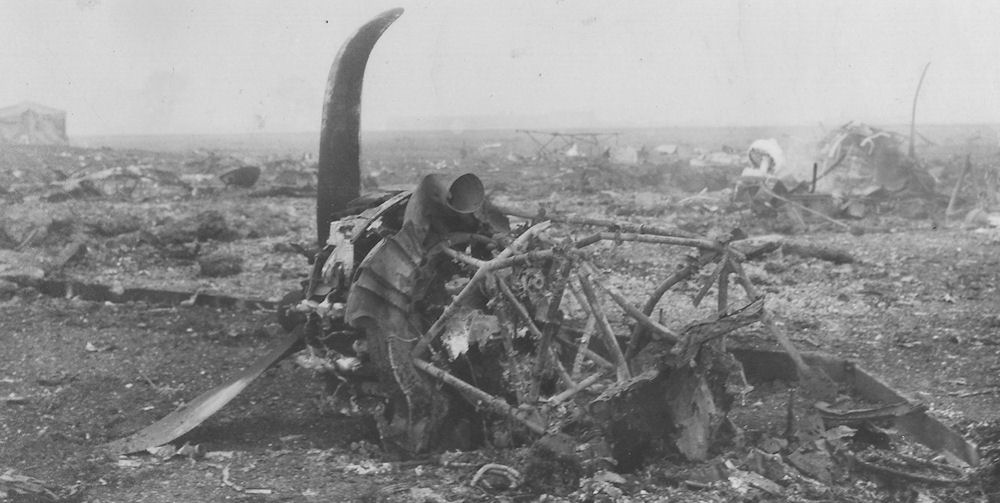
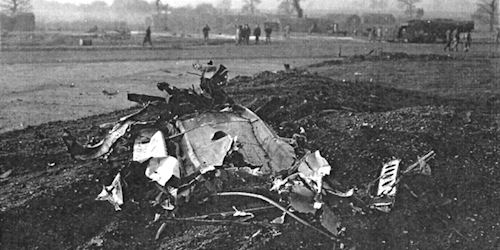
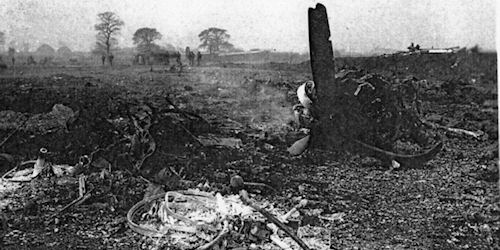
These photos, showing what remained of aircraft 42-7556 after it caught fire in the early morning of 5 December 1943, are ample proof of how dangerous the situation was; they also testify to how ably the men of the 392nd BG contained the fire and minimized the damage to other airplanes, vehicles, and personnel.
January 1944
January 1st was uneventful with the usual garrison duties being performed.
January 2nd saw Sgt Edessa, Cpls Thompson, Squibb, Sobotka assigned to the 105h from Det "A" 317th Service Group per paragraph 12, Special Orders #1 Headquarters 392nd BG. Sgt Comstock was assigned and joined the organization from Gp HQ. Sgt Archer and Pvt Gail Nichols were transferred from the 10th to the Det "A" of the 317th Service Group and atchd for rations, quarters and administration.
January 3rd saw Sgts Norman Nelson, Comstock, Clark and Cpls Bridwell, Squibb, Pfcs Justice, Nichols released from attached and transferred to AAF Sta 115. S/Sgt Rubanich, Sgts Dunn and Cpls Snedded, Boyer and Pvt Baker and Pvt Lambert transferred to 74th Service Squadron per paragraph 9, SO #2, Headquarters 392nd BG. Cpls Nordstrom, Pfcs Labunski, Beeman, Burkhead, Kelly, Talerico assigned and joined the organization from 74th Service Squadron per paragraph 9 SO #2 Headquarters 392nd BG.
January 4th saw an uneventful period of time elapse. January 6th was the same.
January 7th saw Pvt Burkhead transferred to the 465th Sub Depot Class L per paragraph 9, SO #3, Headquarters 392nd BG. Pfc Rauth assigned and joined the organization from Headquarters & Headquarters Squadron, 2nd Bomb Division per paragraph 9, SO #6, Headquarters 2nd Bomb Division dated 6 January 1944.
January 8th was a happy day for Sgt Thompson (then Cpl) as he was promoted to Sgt per paragraph 7, SO #4, HQ 392nd BG dated 7 Jan 44.
January 9th gave 2/Lt Swift a promotion to 1/Lt per paragraph 8, SO #1, HQ ETOUSA dated January 1, 1944.
January 10th to the 16th were uneventful days, with the exception of Cpl Bambauer being sent on Detached Service to Unit Equipment School to AAF Station 101 per paragraph 8, SO #9 dated January 15, 1944 to gain and education in packing life rafts, etc.
January 17th saw a swap of personnel in that Sgts Bowman, Doolittle and Hoover were transferred to the 80th Station Complement Squadron per paragraph 5, SO #14, Hq 2nd Bomb Division dated January 15, 1944 and Cpls Hand, Irving, and Hewitt transferred from the 80th Station Complement Squadron per paragraph 4, SO #15 2nd Bomb Division dated 16 Jan 1944.
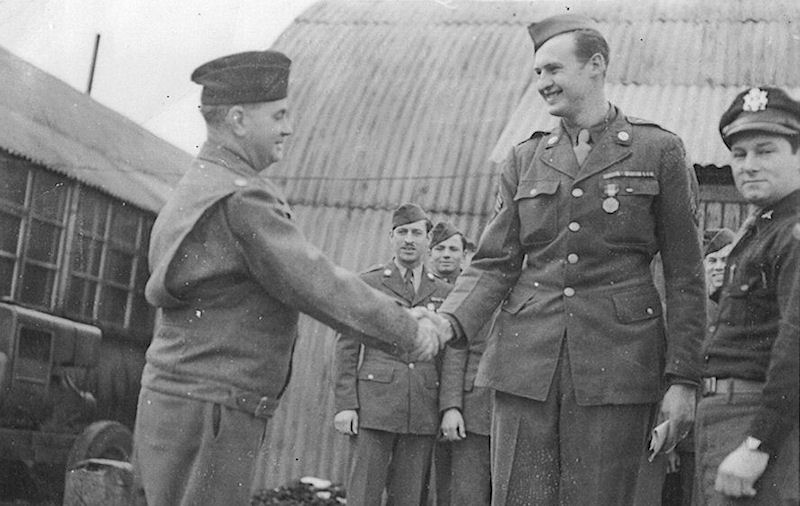
S/Sgt Lee A. Doolittle received his Soldier's Medal, earned for meritorious actions at the 392nd BG on 5 December 1943, after he was transferred to the 453rd Bomb Group.
January 17th to January 21st - usual garrison duties.
January 22nd saw Cpl Bergeron assigned and joined to organization from 12th RCD per paragraph 14, SO #14, Headquarters 12th RCD dated 17 January 1944.
January 23rd was uneventful.
January 24th transferred 1/Lt Greenberg, T/Sgt Hamerick, S/Sgt Tacy, Sgts Malone and Stensland, Cpls Geiger, Glickfeld, Martin and Nelson to 2974th Finance Detachment Class B per paragraph 13, SO #15, HQ 392nd BG dated 23 January 1944.
January 25th and 26th were uneventful.
January 27th saw 2/Lt Erol Coleman and Pfc Richard G. Wells placed on DETACHED SERVICE at Gas School for a period of 12 days per paragraph 8 SO #16, HQ, 392nd BG, dated 25 January 1944. Pfcs Birkes and Roberson were placed on orders to carry out the instructions of the CO per paragraph 2, SO #16, HQ, 392nd BG, dated 25 January 1944.
January 28th saw Capt Robert A. Lip transferred to the 25th Station Complement Squadron per paragraph 4, SO #26, 2nd Bomb Division, dated 27 January 1944.
January 30th saw Cpl Johnson and Pfc Sorenson put in confinement for misuse of government vehicle on Christmas Eve.
During the month of January Capt Dawson and S/Sgt Albert A. Bury successfully passed through the trials of an appendectomy.
February 1944
February 1st put Cpl Tennyson on Detached Service to the Army School of Hygiene Keogh Barracks Mytchett near Aldershot Huts for a period of approximately 14 days.
On 2-12 Feb 1944, the complete squadron was checked for immunizations and also the entire squadron checked their gas masks in the gas chamber. About a week later all personnel were issued the new style service mask so the squadron will have to go through the chamber again shortly to insure the perfection of the new mask. All persons were in hearty approval of the new mask due to its compactness and smaller size.
February the 13th proved to be a lucky day of Cpl Johnson as his sentence was remitted and he was released from confinement. Sgt Travis B. Poole Jr. was transferred to the 576th BG per paragraph 4, SO #25 dated 12 February 1944.
February the 14th saw Sgt Becquart (then Cpl) promoted to the grade of Sgt per paragraph 1, HQ 18th Weather Sqdn, AAF Station 586 dated 1 February 1944.
February the 15th transferred Pvt Maxwell to Disciplinary Training Center #4, APO #546 per paragraph 10, SO #26, Hq 392nd BG dated 14 February 1944.
February 16th to 21st-usual garrison duties.
February 22nd showed Capt Russak assigned per paragraph 8, SO #30, HQ 392nd BG dated 22 February 1944. 1/Lt Hughes was transferred to the 472nd Sub Depot per paragraph 1, SO #41, HQ 8th AF dated 12 February 1944.
February 23rd-usual garrison duties.
February 24th saw Pvt Wam go from duty to temporary duty at Brockwood Cemetery Surry per paragraph 20, SO #30, HQ 392nd BG, dated 22 February 1944.
February 25th saw Capt Mulligan join the squadron per SO #52, HQ 2nd BD as amended by paragraph 4, SO #53 HQ 2nd bomb div dated 23 February 1944 as a medical officer. M/Sgt Gardiner B. Jones Jr. was transferred to Group Headquarters per paragraph 2, SO #31 HQ 392nd BG, dated 23 February 1944.
February 26th to 29th proved to be uneventful with the happy day on the 29th when the "Eagle" turned over and paid again.
The months of January and February saw most of the Officers and Enlisted Men in the Squadron spend their furloughs in either London or Edinburgh promoting Anglo-American relations. All came back with reports of very enjoyable time and great anticipation for the next forthcoming leave.
April 1944
April the first transferred Pfc Luebke to the 10th per paragraph 27, SO #49, 392nd BG, dated 28 March 1944. Pvt Reyna returned from furlough (8 days) to duty and Pfc Smith, Pvts Williams and Telericor went on furlough for 8 days. It also saw 1 officer and 41 EM Co "F" Engineers Regt, 2nd Platoon relieved from attachment for rations and quarters and 1 officer and 42 EM attached for ration and quarters from Co "C" 846th Engineer Aviation Battalion.
April the 2nd transferred 1/Lt Brewster to 576th BS, effective the 1st of April per paragraph 14, SO #50, HQ 392nd BG, dated 1 April 1944. Also 1/Lt William L. Roberts was assigned to Group Headquarters from the 10th Station Complement Squadron per paragraph 17, SO #50, HQ 392nd BG, dated 1 April 1944. Cpl Wermuth of the Medics was placed on Detached Service at maintaining Aid Station is returned to duty per paragraph 10, SO #48, HQ 392nd BG, dated 24 March 1944. Cpl Brooks, Clyde V. also of the Medics was promoted to the grade of Corporal from PFC per paragraph 25, SO #50, HQ 392nd BG, dated 1 April 1944. Pfc Robert A. Martin was lucky and received an 8-day furlough on this date. Pvt Sorenson went from confinement to duty this date upon completion of his sentence in the Guard House. Pvt Sorenson was given a pass and is now happy with the world again. Withal this was a very busy day.
April the 3rd saw Capt Mulligan transferred to HQ 5th CCRC Group per paragraph 1, SO 87 Hq 8th AF dated 29 March 1944. It also saw S/Sgt J. E. Fagan, ex-combat man grounded for frostbite assigned to the 10th as an Ack Ack gunner and Chief from the 577th BS, per paragraph 15 SO #49, Hq 392nd BG, dated 26 March 1944 as amended per paragraph 5, SO #52, Hq, 392nd BG, dated 3 April 1944. Cpl (Cook) Houildin was transferred to the 579th BS per paragraph 6, SO #52, HQ, 392nd BG, dated 3 April 1944. Pvt (Cook) Hardy transferred to the 10th from 579th BS per paragraph 7 SO #52, 392nd BG, dated 3 April 1944. Cpl McElmeel of transportation was placed on Detached Service AAF Station 113 per paragraph 10 SO #51 HQ 392nd BG dated 2 April 1944.
April the 5th transferred 1/Lt Jack W. Swift to the 326th Station Complement Squadron per paragraph 11, SO #93, HQ 2nd Bomb Div dated 3 April 1944. Cpls Sanders and Jakubik went from furlough anxiety to furlough and Pfc Gibbs and Kagan and Pvt Kirk all followed suit for a period of 5 days. Two EMs were also attached for rations and quarters from Co "C" 846th Eng Avn Battalion.
April the 5th saw 1/Lts Perlman and Wolfe attached for rations and quarters per paragraph 1, SO #53, HQ 392nd Bomb Group, dated 4 April 1944.
April the 6th attached 2/Lts Braga, Hess, Horshead from 18th Weather Sq to 10th per paragraph 1, SO #54, HQ 392nd Bomb Group per paragraph 2 also transferred in Cpl Harold I. (Alka) Seltzer for 18th Weather Squadron and is carried as attached. It looks as if the Weather Squadron is expanding. 2/Lt Kersun of Flying Control was also assigned on this date per paragraph 7 SO #54 HQ 392nd BG, dated 5 April 1944.
April the 7th saw 1/Lt Bimson leave on furlough for 6 days and 1/Sgt Nichols, Sgt Reid, and Pfc Johanson go from duty to TD at London, England.
April the 5th released Capt Russak from attachment for rations and quarters effective the 4th of April. 1/Lt Daughdrill was transferred to the 10th from the 578th Bomb Squadron per paragraph 11, SO #56 dated 7 April 1944. 2/Lt Handleman who was on TD at AAF Station 101 is transferred to Detachment of Patients 100th General Hospital APC 152 effective 7 April 1944 per paragraph 7 SO #54 HQ 392nd BG dated 7 Apr 1944.
April the 9th swapped Cpl Wade for Cpl Missant as Cpl Wade was transferred to the 326th Station Complement Squadron per paragraph 13 SO #97 HQ 2nd Bomb Division dated 7 April 1944 and Cpl Missant was transferred to the 10th per paragraph 13, SO #97, HQ 2nd Bomb Division dated 7 April 1944. Pfc Smith and Pvts Williams and Talerico returned from furlough.
April the 10th saw Captain Rossiter return from furlough and transfer to the 2101st Engineer Aviation Fire Fighting Platoon AAF Station 118, effective 9 April 1944 per paragraph 4 SO #99, HQ 2nd Bomb Division dated 9 April 1944. 2/Lts Matheson and Strum attached for rations and quarters effective 8 April 1944 per paragraph 11 SO #97 dated 8 April 1944, Hq 392nd BG. Sgt Stroheim went from duty to TD to London for purpose of carrying out the instructions of CO per paragraph 7 SO #57 HQ 392nd BG dated 8 April 1944. Pfc Martin returned from furlough.
April the 11th saw Pvt Kirk return from furlough to duty.
April the 12th returned Cpls Sanders, Jakubik and Pfc Gibbs and Kagan to duty from furlough.
April the 13th brought Cpl McElmeel from Detached Service AAF Station 113, per paragraph 10 SO #51 HQ 392nd BG dated 2 April 1944 to duty. It also attached 1 officer and 44 EM CO "C" Engineer Regt 2nd Platoon elsewhere and they are relieved from attached for rations and quarters this date.
April the 14th 1/Sgt Allen and Pfc Carey go from duty to TD for the purpose of carrying out instructions of the CO per paragraph 6 SO #60 Hq 392nd BG dated 13 April 1944 and it also transferred Cpl Holevoet, Wand, Pfc Kleckner, Pvt Santora, Williams to the 2101st Engineer Fire Fighting Platoon per paragraph 2, SO #60, 392nd BG dated 13 April 1944.
April the 15th saw Sgt Stroheim return to duty from TD per paragraph 7 SO #54, HQ 392nd BG dated 8 April 1944 and also 1/Lt Bimson return off furlough to duty.
April the 16th saw S/Sgt Allen and Pfc Carey to duty from TD and also saw the following assignments in officer personnel per squadron orders to assigned duties. Capt Dawson appointed Sq Unit-Officer-Non Tactical per paragraph 2, Hq Sq O #6 dated 9th Apr 44; Capt Glettler and 2/Lt Kreisman appointed Squadron Flight Control Officers per paragraph 3, Sq O #6, dated 9 April 1944, 1/Lt Daughdrill appointed Squadron Mess, Supply and Transportation Officer per paragraph 1 Sq O #6 dated 9 April 1944, 1/Lt Bimson appointed Sqdn Utilities Maintenance Officer per paragraph 4, Sq O #6 dated 9 April 1944, 1/Lt Barnhill appointed Sqdn Technical Inspector per paragraph 6, Sq O #6 dated 9 April 1944, and 2/Lt Fish appointed Sq Chemical Officer per paragraph 5 Sq O #6 dated 9 April 1944.
April the 17th promoted 1/Lt Burke to Captain per paragraph 17 SO #92 HQ ETOUSA dated 1 April 1944. Cpl Breitenfeld (attached weather man) promoted to Sgt per paragraph 1, SO #51 Hq 18th Weather Sq APO 633 dated 1 April 1944. Pvt Phillips was released from confinement and transferred to the 2912 DTC APO 506 per paragraph 12, DO #61 dated 15 April 1944, HQ 392nd BG.
April the 18th transferred attached M/Sgt Donald O. Myers to HQ 328th Service Group AAF Station 170 per paragraph 1 SO #67 HQ 18th Weather Sq APO #633 dated 11 April 1944. It also sent Cpl White and Pvt Roy E. Carey on TD to Manchester for the purpose of carrying out the instructions of the CO per paragraph 3, SO #52 HQ 392nd BG dated 17 April 1944.
April the 19th was the first quiet day of the month for the 1/Sgt and his Morning Report.
April the 20th transferred Pfcs Keach and Spray to the 10th per paragraph 9 SO #62, HQ 392nd BG dated 17 April 1944. S/Sgt Fell assigned and joined per paragraph 7 SO #63, 392nd BG dated 18 April 1944 this date.
April the 21st transferred Pvt Aranda to the 10th per paragraph 6, SO #64, HQ 392nd BG dated 20 April 1944. Cpl White and Pvt Carey returned to duty from TD to Manchester and Cpl Sobotka went from duty to TD for 2 days for the purpose of carrying out instructions of CO per paragraph 11 SO #64, HQ 392nd BG dated 20 April 1944.
April the 22nd returned Cpl Sobotka to duty from TD.
April the 23rd shot the TO of the 10th when M/Sgt H.E. Nelson joined the squadron per paragraph 4, SO #56 Hq 392nd Bomb Group dated 22nd April 1944 and also the following named EM assigned and joined from 401st Bomb Group per paragraph 5 SO #112 Hq 2nd Bomb Division dated 22 April 1944-S/Sgts Chrisey, Wallace, Sgt Pelito, Cpls Cooper and Yunt, Bisberger and also Sgt Trant joined organization as attached Weather Sqdn man per paragraph 3 SO #66 dated 22 April 1944 and Pfc Joseph t. Reilly transferred to HQ 14th Combat Bomb Wing per paragraph 19 SO #111 Hq 2nd Bomb Division dated 21 April 1944. Pfc Bittar went from duty to TD at RAF Station Watchfield Airfield Controllers School per paragraph 1, SO #56 HQ 392nd Bomb Group dated 10 April 1944.
April the 24th Pvt Carey returned to duty from TD for the purpose of carrying out instructions of CO per paragraph 4 SO #65 HQ 392nd Bomb Group dated 21 April 1944.
April the 25th and 26th were quiet days.
April the 27th saw 2/Lt Delia relieved from attached per paragraph 2 SO #76, HQ 18th Weather Sqdn dated 22 April 1944. Cpl Brooks of the Medics placed on TD to RAF Station Hawkings per paragraph 11 SO #69 392nd Bomb Group dated 26 April 1944.
April the 28th saw Sgt Breitenfeld relieved from attached for rations quarters and administration per paragraph 1, SO #70, HQ 18th Weather Squadron dated 26 April 1944.
April the 29th and 30th were uneventful days rounding the month out in good order.
During the month of April the following changes were made in Officer Personnel assigned to Squadron duties.
1/Lt Cooley was appointed Squadron Adjutant vice 1/Lt Roberts per paragraph 2, Squadron Order #4, dated 4 April 1944.
1/Lt Cooley was appointed Squadron Historical Officer vice 1/Lt Roberts relieved per paragraph 1, Squadron Order #4, dated 7 April 1944.
June 1944
NOTE: The history for June 1944 was not on the microfilm. However, this supplement was; it was included in the April 1945 history as part of the final chapter of the 10th Station Complement Squadron:
As part of the closing of the history of the 10th Station Complement Squadron the following excerpt of one of the men is printed to show the feeling of loyalty and unity the men of the outfit had and that good old never-say-die spirit of American patriotism. This fellow was a plane guard on the memorable night of 5 June 1944 when the boys were on their way to hitting the Normandy beach the next early morning - "D" Day, 6 June 1944.
Supplement to June 1944 Sqdn History
Probably the third most important date that will be remembered in connection with World War 2 is 6 June 1944, the other two being of course 7 December 1941 and the great day of peace to come.
I was on plane guard on the night of the 5th of June and although I've never enjoyed pulling guard duty, I'm glad that I was picked for that detail on that particular night. We hadn't been told, but as is usually the case, you can feel when the "big" thing is at hand.
The crew gunners came out to their ships from briefing at about midnight, knowing fully well that this was the mission. They checked, double-checked and then rechecked again all armament and other necessary equipment. About 0200 hours the ships' Officers, pilots, co-pilots, navigators and bombardiers came out. Each man had that certain tenseness about him, that extra something that showed that this was not just 'another one'. Finally all crew members got into their ships. Motors purred then vibrated to a deafening crescendo. At 0300 hours the first ship started down the runway. At assigned intervals one after another seemingly flapped its wings in the night and headed for the dark uninviting skies above.
There they were, going to join the mighty air armada that was to cover the greatest landing feat in the history of warfare. For months, they had been dropping tons of havoc in preparation for this day. Many of the airmen were up there doing their best to provide a cover for their brothers and friends that might be below.
Stories of the invasion will be reread and retold for years and years to come, but nothing will ever erase that thrill, as I stood there that night, watching, praying, that those big planes, whose bomb bays would soon be opening on their greatest endeavor, would save the lives of countless of my unknown buddies in khaki.
July 1944
During the month of July not much happened to the 10th outside of a few items which will be noted in the contents of the following. The general feeling and morale of the men in the Squadron remained as high as it always has been. The current invasion of France and the increased Russian Offensive haven't caused too much excitement for the 10th outside of an increase in missions and sorties therefore causing a great increase in the amount of work that has to be put out each day by the personnel assigned to Flying Control. The men in that section and all over the field for that matter are all pepped up and feel that each mission and all the work they produce towards that mission brings us all closer to final victory and above all home.
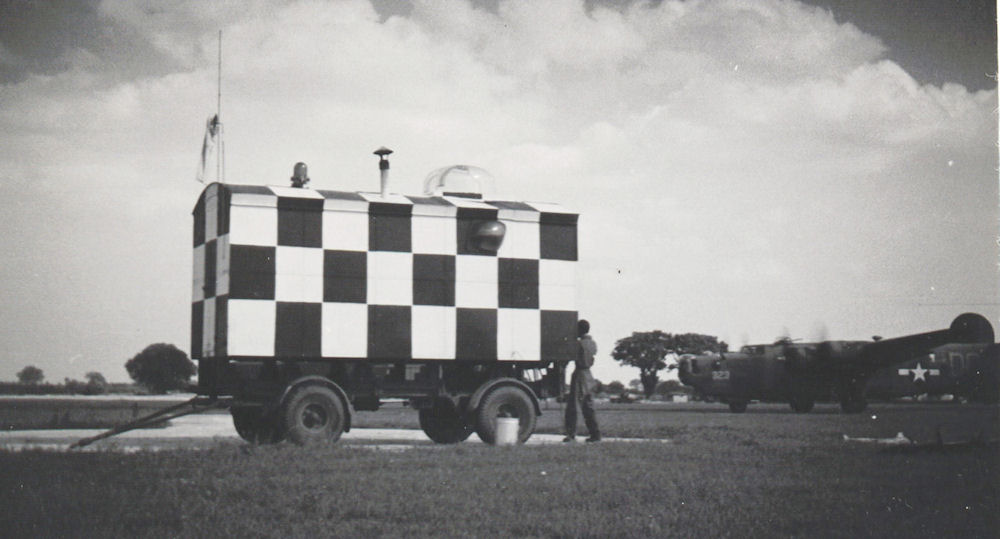
Although during the month the 10th was authorized to reduce its nightly number of guards on the planes the Squadron is still feeling the effects of tying personnel up in doing Guard duty. The authorized number at the present is five to a shift thereby using ten men a night. Also in July the order instructing all personnel to carry their battle equipment with them at all times was amended and now it is only necessary to carry the battle equipment to and from places of work.
The Base Utilities section of the 10th has been forced to increase its already schedule of more and more work to more work. Consequently the personnel assigned to that department have been restricted to the base and are working night and day pouring concrete on the runways and doing the other many jobs about the base. The Squadron Commander upon request gave them a helping hand and removed the Utilities section of the squadron off the duty roster for a period of two weeks.
The only relief in the pass situation for the month of July for the remainder of the personnel in the Squadron was the lifting of the 25-mile restriction so that now the men in the Squadron can go to towns such as Wisbisch [probably Wisbech], Long Sutton, Boston, Spalding, and Cambridge legally on their 24-hour passes.
Along with its policy and actuality of having the best barracks and area on the base-rated Superior by the Group Executive Officer on his inspection-the 10th is now striving towards the goal of being the most military unit on the base. A system of close order drill was established so that all enlisted personnel of the Squadron get in at least six hours a week of drilling. The drill periods were held between 0730 and 0830 hours in the morning and between 1300 and 1400 hours in the afternoon. This drill has been in effect for about three weeks and we hope it will end around the first or second week in August. Much improvement has been shown in the military bearing and military courtesy of the personnel in the Squadron since this drilling has commenced. It also gave the non-commissioned officers of the Squadron the chance to see how poor they were as drill sergeants and consequent training derived from drilling men during this time has made many of them realize their responsibilities as a non-commissioned officer more thoroughly and even made better soldiers out of them. The favorite saying of the men in the squadron during these drill periods is that we are training to go overseas and march down Fifth Avenue in New York. The overseas part naturally means going back to the states as most of the boys have been over here a year or better and some darn near two and a half years.
The 10th had its party this month and a good time was had by all. The party went off in a much smoother fashion that some of the preceding parties due perhaps to a more sufficient quantity of beer and the fact that the girls were not allowed to wander about the base as before therefore causing more of them to be at the party. As has happened in the past about half of the gals would wind up in different living sites on the base with their steady boyfriends. Also at the last party the 10th was only allotted two 36-gallon kegs of beer due to a shortage whereas at this party the 10th had five 36-gallon kegs of beer-one more than it should have but that was to make up for the lack of beer at the last party. All had a good time and the gals also went home pleased with the outcome of the party. Some of them were in pretty fair shape at that.
The bicycle situation still prevails but only a few isolated instances were noted of one or two of the men suffering from "bicyclitest". All but one of the eleven missing bicycles has been located and a report of Survey is being initiated to cover the loss of that cycle. S/Sgt Andrews the Supply Sergeant really did a good job in locating some of the missing cycles. Bikes are his biggest problem at the present time.
The Station Defense is still using combat men who have completed their 30 sorties over Hitler's territory as part of its personnel in addition to the regular personnel that is assigned to that section. Their nightly hours have been shorter this month but will pick up as darkness increases. So far they only have had to go to their respective pits each night and we hope no enemy action makes them do otherwise. The boys are always on the job however and ready for any action that might occur.
Part of the personnel of the 10th attended fire-fighting lectures put out by the Station Fire Marshall during the month and the entire squadron is to attend a demonstration on fire-fighting equipment and a lecture sometime in August. The men were instructed in the proper equipment etc to be used in extinguishing any type of fire that might possibly present itself. It is a good thing for the personnel of the squadron and all men attending the classes really appreciate what they are learning.
The 10th Station has in its command one of those freak accidents that happens once in a life time. Two enlisted men have the same blood type-O-same last five serial numbers alike and both are Pfcs. They are Pfc John F. Pace, 32770743 and Pfc Lowell E. Poor, 19070743-one enlisted and one was drafted. They came into the Army at almost a year apart, Poor in Jan 42 and Pace in Feb 43. Their clothes are both marked the same P-0743 and could be P-70743. This is quite a rarity and happens once in a great while.
On the 19th of the month the fourth man of the squadron to be married to a British bride walked the long path with the first sergeant, Condy E. Nichols of Marlin, Texas as his best man. Major Daughtrey of Del Rio, Texas was also present at the ceremony and presented a speech at the reception. The wedding took place in the St. Nicholas Church at Kings Lynn, Norfolk, England. It might be said that the bride was a very beautiful woman and all felt Labunski was a lucky man. The bride and groom were Miss Deborah Whittaker and Leo Labunski now Mr. and Mrs. Leo Labunski. The reception was much more than expected and was enjoyed immensely by all.
During the month Capt Karl E. Johnson assumed the duties of Base Utilities Officer in lieu of Lt Bimson. Capt Johnson is assigned to the Corps of Engineers and not the Air Corps.
In order to promote a more complete picture of the duties performed by the personnel of the 10th a departmental roster is included in this month's supplement and it may be seen by that that the 10th does everything but fly the ships on the base, it seems.
Sometime in July the 392nd received official notification of a citation awarded them from Division Headquarters. It was General Orders Number 97, Headquarters 2nd Bombardment Division. As a result the public relations officer issued the following statement to be completed by all personnel on the station and in turn sent to the home town newspaper of the personnel.
"AN EIGHTH AIR FORCE LIBERATOR STATION, ENGLAND:--____________ of ________, is a _______, in this Group, cited for distinguished and outstanding service in 100 combat missions over Europe. The Group, commanded by Col. Irvine A. Rendle, of Rawlins, Wyo., made its 100th mission in support of the initial landings by Allied forces in France. The citation, issued by Brig. Gen. James P. Hodges, Division commanding general, covered missions to Berlin, Friedrichshaven, Poland, Norway, Holland, Belgium, Gotha and France."
This closes the history for this month of July and we all hope August sees the war closer towards the end. Hitler appears to be on his way out and we are all pushing like hell to help him "get up them stair."
August 1944
In the past history-making month of August in World War II, the 10th has continued to play its small but important part in keeping the heavy bombardment "Libs" over the boys in France. The personnel of the Squadron purchase the English newspapers each day and after chow rush to their various maps in corresponding offices to color the path of General Patton and the Allies. It seems like every office has its own little war map and the English papers help to fulfill the mission of following the Allies and General Patton on paper.
During the month several changes and also duty changes happened to the officer personnel of the 10th. Lt Bimson was appointed Squadron Soldier's Voting Officer and after setting the correct system up he was transferred to the 2101st Fire Fighting Platoon on this field and Lt Daughdrill was appointed Soldier Voting Officer in his place. Next Lt Cooley was transferred to Group Headquarters necessitating a new Squadron Adjutant and Historical Officer. Lt Daughdrill was selected by Major Daughtrey the unit commander as both the new Squadron Adjutant and also the Squadron Historical Officer and in addition he was assigned the duties of Squadron Transportation Officer, Squadron Mess Officer, Squadron Supply Officer, Squadron Postal Officer and last but not least Squadron Historical Officer vice Lt Cooley transferred. S/Sgt C.E. Nelson is the NCO in charge of this activity working under the direction of Lt Daughdrill.
All the men of the 10th were read and explained their Soldier's voting rights etc by Lt Bimson before he transferred. Each man signed individually for the War ballot card and the record of this is on permanent file in the Orderly Room.
In the first week of August personnel of the 10th attended a lecture or fire show held on the station's ball field demonstrating how to use various types of fire extinguishers and foam, water and other expedients in putting out fires. It was very educational and interesting to see and all personnel received plenty of good out of this lecture. Perhaps some day it will save a good deal of money.
One thing happened during the month that most of the fellows agreed on and that being the stopping of the morning drilling by Major Daughtrey as on the 9th of August the entire morning formation which practically resulted in the complete squadron passed in a more or less informal review before the Commanding Officer and it might be added that the boys looked pretty sharp. This ended the drill periods for now and it has become apparent that the period of drill did show fruits in that the personnel of the squadron have proved to be better soldiers and military courtesy has definitely taken a turn for the better since the drilling started. It turned into a good thing and unlike other good things was not run into the ground.
After the drilling was completed the entire enlisted personnel of the squadron were subjected to a show down inspection of clothing and equipment. All the clothing and equipment had to be in A-1 shape and properly marked in accordance with existing Army Regulations. Shortages now in the process of being corrected and sometime in September another show down inspection is anticipated.
Much of the men in the outfit had an increase in morale this month as first the 48 hour passes opened up and towards the last of the month furloughs opened up. The men started taking passes to London again (buzz bombs and all) and some to Edinburgh-Scotland in general seems to be the bait or main attraction for furloughs-guess the boys like the Scotch beer not to mention the gals. It looks again as if part of the pay roll of the 10th is going to go into the purses of some of the lucky Piccadilly Commandos who get one of the boys. An old profession that will never die especially so around some G.I.'s. At any rate the boys all feel better now that again they will be able to get away from camp life for a short while.
Most of the boys sprouted forth with their shining overseas stripes this month some entitled to wear as many as four or five denoting two or more years over here. The stripes cause quite a sensation on the local scene as some of the local townsfolk couldn't understand why we got overseas bars for being in England but after they realized that we were long ways from home the subject would be dropped.
A list of enlisted men was furnished headquarters for the part the 10th plays in the honor guard for the field. These boys drill a period of once a week or more at the discretion of Captain Lane who has charge of this body of men. We all hope that it is a period for training looking forward to the day we leave Wendling and head for the U.S.A.
This month a new experiment has been instituted to see if an inspector can do a better job of inspecting by being billeted away from the men he inspects. Consequently the aircraft inspectors belonging to the squadrons were transferred on Special Orders to the 10th for a period of TD necessitating their moving from the squadrons in which they are assigned. In shorter words it was felt that personnel making inspections should not be billeted with personnel who they have to inspect thereby enabling the inspector to make a more accurate inspection dodging all the personnel conflicts that might come forth after the day's work is finished if the men were billeted together. So far the system is proving to work out quite satisfactorily. These men were M/Sgt's Shea, Wallace & Rohrkaste. M/Sgts Nelson and Andrekotich are assigned to the 10th as regular inspectors so consequently that makes a total of five M/Sgts in the 10th as inspectors. Sgt Andrekotich came to this field from North Pick when it broke in parts and the 491st moved in.
Following is a roster of the 10th by departments as it is felt that by submitting this roster each month the reader will be more fully able to understand the type of work that this particular Complement Station is doing on this Airdrome:
Squadron Orderly Room
Administrative Inspectors Office
Enlisted Personnel
Message Center
S-4 Office
Technical Inspectors
Special Services Office
Station Defense Office
Chemical Warfare Office
Base Utilities
Communications Office
Transportation
Flying Control
AA Defense Gunner
SD with the Military Police
Mess Personnel EM #2
Combat EM Mess
Enlisted Mess #1
Combat Officers Mess
Ground Officers Mess
Fire Department
Group Equipment
Photo Lab
Orderly for Col. Johnson
Billeting Quarters
RAF Equipment Office
Post Exchange
Medical Department
Aero Club
It is hoped that by the submission of the above roster that it may easily be seen the type and quantity of work that the personnel of the 10th are called to put forth on this station.
At this time it is also felt that the following true copy of AAF Training Standard No 40-12-1 dated 19 August 1943 should be included in the history so that the original mission of this type of complement squadron be identified as such.
2. a. Mission. The mission of a Station Complement Squadron, Special, is the performance of the various base housekeeping duties which will continue during the absence as well as the presence of other combat or service units. Specifically these duties will arise from the operation of base utilities, operations, base dispensary, supply section, fire department, telephone and teletype circuits, base gas defense SOP, and any necessary fatigue details. This is an extract of this training standard which is meant to give an idea of the duties of this outfit.
In the beginning of the month a trip was arranged by the squadron and special services to take a limited number of officer and enlisted personnel to the King of England's private estate called "Sandringham." Pfc Henry Hewitt of the Orderly Room went on this trip and consequently wrote the following report on the days activities.
"Leaving the squadron area at 0800 hours and traveling by way of Kings Lynn the six Officers and twelve enlisted men making the trip arrived at Sandringham the King of England's private Estate at 0930 hours. The Estate is situated seven miles north of Kings Lynn. We were met at the East Gate by a guide, who took us first to see the royal family's trophy room. Here we were shown a very fine collection of wild game shot by the late King George VI, King George VI and members of their families. T/Sgt Savage from the base photo lab took some fine shots of the interior for the station public relations office. We were then taken around the Royal residence which is quite large. The extensive gardens and lawns around the residence are nearly all given over to farming now. We were struck by the fact that potatoes were growing very near the house and what was a golf course before is now a wheat field. The whole estate is well-forested with large and various varieties of trees, which was a treat after living for the past year in a part of the Isles where the oak predominates. Our guide led us up a path and through a gate in the brick wall that surrounds the grounds immediately around the residence and which leads up to the church of St. Mary Magdalene where the Royal Family attend church when staying at Sandringham. We were met by the rector of the church who took us around and through the church, and explained its salient features. The church building appeared at first from the outside to look very much like the other small country churches found in this part of the country but after we had a chance to examine the interior we all came away with the knowledge that it was very beautiful and was another symbol of what the Royal family stands for and means to the British people. The chancel would take a book to describe with its carved and painted decorations to the roof. The Altar and Reredos [a screen or decoration behind the altar] contain 2000 pounds of solid silver and were the gift of the American friend and admirer-Rodman Wanamaker to King George V, the Peacemaker.
The Vicar asked our photographer if he would take a picture of his year-old baby as film for them was very hard to get. Our photographer and several other amateurs in our party had great fun trying to get photos of the baby laughing, but there were just too many Yanks around and he had a very solemn expression all the time. We were then taken through the estate and into the Royal gardens which were very much like our civic parks at home except that a very large percentage of the garden is under glass. We were all surprised to see all kinds of fruit trees and grape vines growing in the hot houses. Most all the trees were espaliers [an ancient form of gardening where fruit and flowering trees are trained into pleasing symmetry in a flat plane, as against a wall or other support] and in some cases followed the curve of the roof of the hot houses. All the walls were faced with espalier trees.
The estate of Sandringham was purchased in 1861 by King George V and it was there that he died in 1900. We all came away with a feeling that we had seen something we could remember and tell about when we returned home.
On our way home we stopped at Castle Rising which is four miles north of Kings Lynn. Castle Rising is one of the best specimens of a Norman Village left to see. Our truck and cracker box pulled up beside the stone wall which parallels the moat and we climbed out. Pfc Hewitt went looking for the caretaker to let us through the gate, but could find no one and so we all jumped over the fence saving ourselves 6 pence each. This Castle is of particular interest because of the moat which is one of the deepest in England; also the Castle stands by itself and has been altered very little, since the fifteenth century. The windows are very large and handsome for the period when it was erected and of peculiar construction, the general outline being circular. They appear to be part of the original work. The entrance is by a fine outside staircase similar to that at Newcastle. Over the entrance door are two circular windows of rather uncommon appearance and perhaps unlike anything to be found elsewhere. As time was getting short, some wanting to return to the base in time for noon chow, we left before we could study all the details as much as we would have liked. We returned by way of Kings Lynn, some getting off there who had 24-hour passes. The following named officers and enlisted men went on the trip-Major E.R. Daughtrey, Captains Franklin W. Dawson, William L. Roberts, First Lieutenants Lloyd A. Bimson, Asa B. Cooley Jr, James V. Goar Jr and S/Sgt John D. Halloran, T/Sgt John L. O'Connor, Sgts Barkdull, Enlow, Chambers, Cpls Hand, Ray, Becquart, Rosen, and Pfcs Hewitt, Doveatt made the party complete."
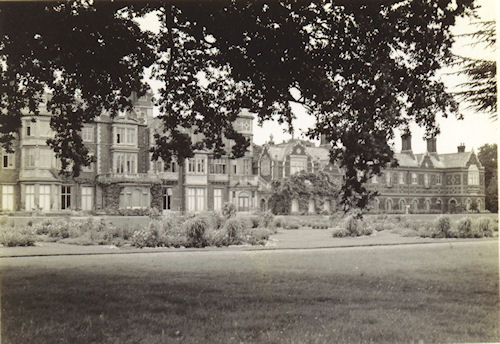
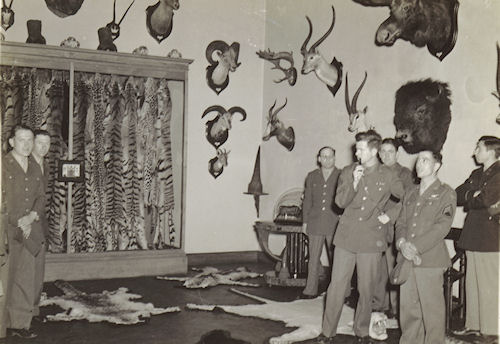
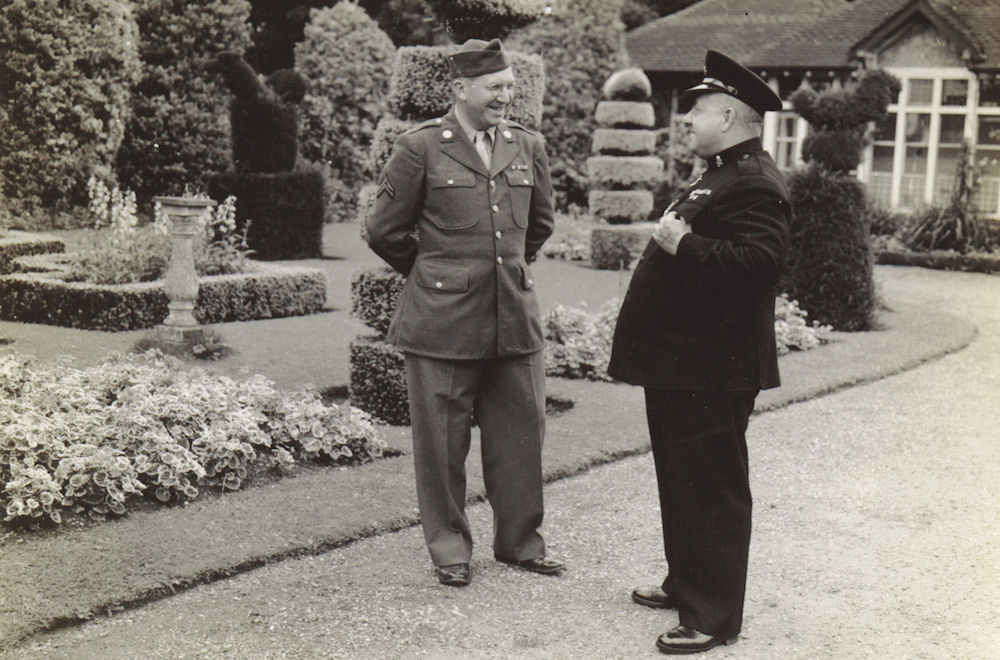

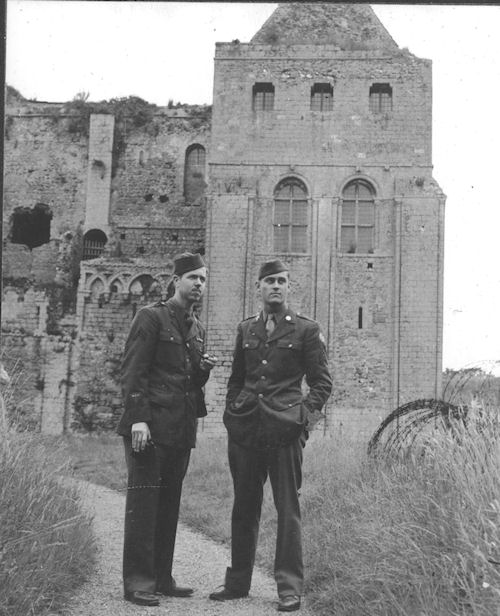
This is just about all for the month of August and next month will tell the tale of the results of the big bond drive and chances and winner of the $1000 dollar bond.
October 1944
The Squadron History for the month of October seems to be rather negligible in that not much happened to the 10th and its personnel with the exception of the four or five highlights which follow.
On the 4th, 5th, and 6th the personnel of the squadron practiced their rights as American citizens and went to the squadron polls to vote. Lt Daughdrill and S/Sgt Reid handled them in the proper manner and their ballots were executed in utmost secrecy. Not many of the men voted by the Federal ballot however as many of them had already received the State ballots from their respective states.
Friday the 13th proved to be an eventful evening for the boys who stayed in the camp in that about 2040 hours three buzz bombs strayed off their course and came close to the squadron site. The first buzz bomb according to the flying control personnel in the tower could have made a perfect landing on our main and longest runway and that at the time it crossed the field it was lower than the second story of the flying control building which would make it about 15 or more feet off the ground. Completely too low for comfort for one of those babies. There was no alert sounded because these buzz bombs came so fast that there was not enough time to summon an officer to announce an alert.
The first buzz bomb went parallel to the squadron site at a still low altitude and the boys watching it only hoped that the motor would keep going and not cut out which it didn't but drove itself into the ground and an explosion in a pond just outside of Longham about two miles from camp. About the only damage it did was to deepen the pond and water the surrounding territory.
The second one was much farther away from the camp and all that was seen was the explosion flash but the third one went right over the squadron latrine about 100 feet in the air and the men in the area at the time had for most of them their first look at a buzz bomb. The bomb landed in the suburbs of Wisbisch [probably Wisbech] about 35 or 40 miles away. This was the first time some of the fellows had ever been close to a buzz bomb and its results and they really did gain a lot of respect for them. In fact most of the men thought that the first one was the RAF going out or coming back low as the dickens until someone shouted "buzz bomb" and then the fellows rushed out to see the flash and hear the explosion.
Later on in the month a series of violations kept coming in on the enlisted personnel of the squadron so that Major Daughtrey finally came to the conclusion that the only way to stop this influx of violations was to give the personnel of the squadron a little basic training out of the Soldiers' Handbook. This idea was further helped along when one of the men before the Commanding Officer for Company Punishment decided that he would rather take a Courts-Martial than Company Punishment under the 104th Article of War for the offense of not having in his possession a European Theatre of Operations identity card which upon being investigated had never been issued to him therefore being the fault of the Station Personnel Section. The offense only called for a reprimand or some minor disciplinary action and the man did not realize what he was asking for. Therefore due to the violations etc the men of the squadron went to classes covering the following subjects: Military Courtesy; Care of clothing and equipment; Proper use of the Uniform; Proper conduct on pass; Military Sanitation; Articles of War; Amount of records etc necessary to be on person while on pass; Where to wear the "dog tags"; and a general talk about the Soldiers' Handbook. So far these courses have seemed to do a great deal of good in that the violations have reduced in number and seriousness of offenses. The classes were held during the restriction of the whole ETO on another AWOL pick-up drive so consequently the men were not held back from passes etc due to the program.
During the month a blood donor drive was held and all personnel of the squadron having type "O" blood were requested to report to the hospital if they felt they could spare a pint of blood for the boys in the fronts of the world. Out of 93 men in the squadron having Type "O" blood, 81 reported and donated a pint of blood to the cause. Out of the 12 men who did not report most of them were on furlough and the others were unable to give a pint due to their age or physical condition at the time.
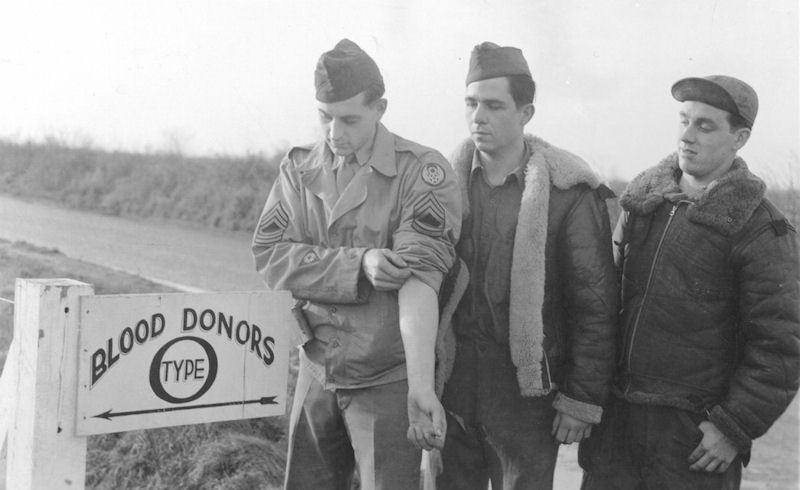
In closing we might add that this month as all the rest the men keep returning from furlough (single men) with severe cases of puppy love on some gal they met while in Scotland or some other place in the British Isles. The average stay of the men in the outfit over here is now about 18 months.
November 1944
The past month of November has seen the morale of the personnel of the Squadron fluctuate with the rise and fall of Christmas parcels from friends and relatives back in the good old U.S.A. One of the big differences this year, however, in the facial and mental expressions of the men as they opened their packages was the whoops of joy and festivity when they would come upon a carton of cigarettes or spare packages of them. Brand and favorite brands of cigarettes were of no object as it is now impossibility for a ground crew member to purchase fags through the Post Exchange and the English type of cigarette are definitely not up to the standards of Camels or Chesterfields or the likes. In fact if the boys went to town and spent a half crown a pack for Players or Woodbines they would be dead broke in no time. This situation of "no smokes" for the ground crew men is really becoming acute. It is fairly difficult for a man who has smoked for the past 20 years or less to just all of a sudden stop smoking and break away from the nicotine habit. Although there is no doubt that is the best road to long wind and good health. Some of the more heavy type of smokers are already showing their nerves etc because of the lack of a weed. At any rate this cigarette shortage has really brought out the pipes and all types, varieties and models are floating around the station. It is a common sight now to see a man riding a bicycle in a cloud of blue smoke with a pipe clenched firmly between his teeth. It is a wonder that some of the enlisted personnel haven't landed in the hospital due to sighting an officer at the last moment and then saluting with the right hand and grabbing his pipe from his mouth with the left hand while the bicycle merrily rolls along its way caring neither for the officer or the enlisted man and his pipe. The two men from the 10th who are assigned to the Station Post Exchange have really put in a trying period of time listening to the complaints of the men due to the cigarette shortage. About the only answer they have is to tell the beefers to go see the Chaplain and as an oddity the Chaplain is the Post Exchange Officer. The T.S. tickets are practically all punched out by now.
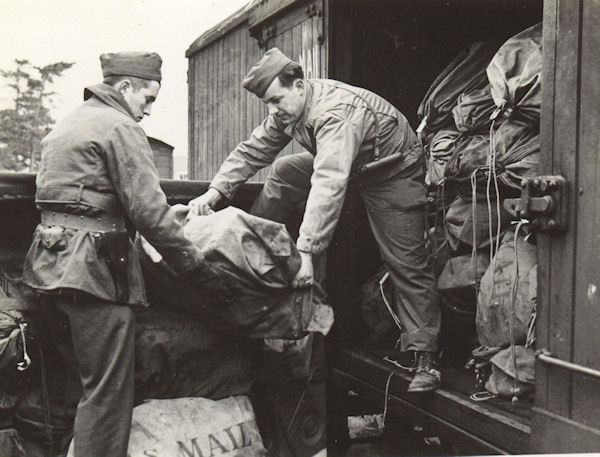
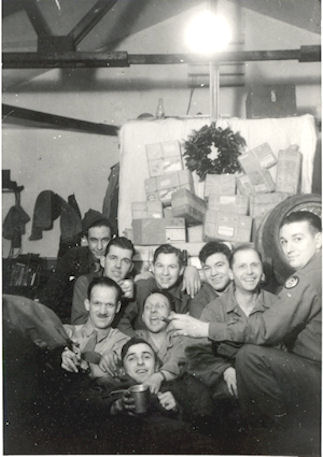
At left, lots of Christmas mail was delivered on 1 November 1944. On right, 392nd personnel enjoy what was in their mail (photo from Mighty Eighth Air Force Museum).
It seems there was really a lot of rain this past month as it was either raining or getting ready to rain all month long. Probably a streak of fate because at the first of the month all overshoes were picked up and supposedly shipped to France. Later on the personnel of the squadron had to relinquish their shelter halfs, tent pegs, rope, canteen and cover, mess kits to the same cause. We hope these supplies are helping the boys over there in the fighting front a great deal.
Flying control tells us that on the 11th of November the Group completed 200 missions over enemy territory. It took five months and five days to complete the other 100 missions as the first 100 missions were completed on June 6, 1944 - "D" day in support of the Allied landings in France. It is rather odd that the Group completed their 100th mission on "D" day and their 200th mission on "Armistice Day."
The men all sweated out the results of the election with the Republicans pulling for Dewey to win and the Democrats pulling for Roosevelt. A few bets were placed but that was about all as the fellows all had their jobs to perform and that primary effort of doing all possible to win the war in spite of elections or not came first.
It also brought about for the majority of the men in the outfit a second Thanksgiving Day dinner in the ETO. Mess Hall #3 certainly did themselves justice in that a very elegant meal was prepared and served in accordance with quality and for once quantity. No one went back for seconds and most of the men wondered just where they were going to put the full course of the dinner from soup to nuts literally. It was an excellent meal and all the men gorged themselves and upon leaving the dinner table headed for the barracks and the good old sack if possible to sleep off the effects of so much good food. The enlisted men's club opened at 1500 hours and the more hardy of the men went to guzzle some brew. Withal it was a red letter day as far as chow was concerned for the average G.I. on the field. The cooks of mess number two did a fine job.
Sorry to say but the following day many of the men fell heir to from slight to severe cases of the G.I.'s. The blame was put on the dark meat of the turkey by some of the mess personnel. It was too bad such a fine spread of food had to be followed by an illness of that sort. Inconvenient at any time and anywhere.
The entire squadron was shot on the 26th and 27th of the month for Typhus at the Station Dispensary. Also on Sunday the 26th of the month the enlisted personnel of the Squadron opened wide in front of the Orderly Room - no rain for a change - and had a Dental Inspection.
On Saturday the 23rd Station Ordnance inspected the carbines and other types of arms of the squadron with a few men getting gigged for dirty guns and a few were rusty in spots. Not many however. Company punishment action was taken to insure that these men learn their lesson and keep their pieces spotless after this.
Well we close now hoping that next month brings us closer to home both mentally and physically.
December 1944
The past month of December hasn't proved too exciting so thanks to the efforts of Irving Kagan of the squadron's communication department we are able to submit a complete account of the Squadron's sports activities since it was activated back in Jacksonville, Florida.
"TIME OUT"
In October, 1943, inter-squadron athletics was inaugurated at this station. Football was in the air at the time, so the first tournament was to be a touch-football league. Special Services donated a trophy that was to go to the winning team and this trophy became the immediate objective of all competitive-minded athletes in the 10th Station Comp Sqdn. After winning five out of six games, our outfit was tied with the 578th Bomb Sqdn. Then came the much-publicized play-off game on New Year's Day and the inevitable 10th Station victory by a score of 18 to 6. The trophy, a silver eagle mounted on an oak base with the inscription "Football Champions, 392nd Bomb Grp, 1943," still rests in the squadron orderly room for all to behold and respect as the sign of 10th Station supremacy. This is the squad that put the trophy in our hands. Ends: James Poe, Charles Jackowski; Guards: Albert Bury, Steve Soroka, Calvin Hall; Centers: James Horton, Tony Hernandes; backs: Raymond Hoffman, Irving Kagan. Also Fred Rossi and Jack O'Brian.
Next on the agenda was basketball, and here too we presented a formidable array of athletics. Sad to relate we didn't win the championship, but we weren't eliminated until the last game on our schedule. Then, after leading at halftime, we lost by 4 points. The basketball stalwarts were Chas. Rauth, Calvin Hall, Dee M. Moore, Irving Kagan, Joe Lamb and Jack O'Brian.
Baseball was now in the line-up and a softball team was formed. In a season marked by some great ball playing and marred by our blowing some big leads, we wound up in record of five wins and four losses. Highlights of the season were our beating a previously-undefeated officers' team 17 to 8. (The 10th Station T.O. was officially closed immediately thereafter.)
A touch football league was formed as in the previous year, but after about five games it was disbanded.
At the moment, we are in the midst of a very exciting basketball season. The schedule is broken into two parts, the first ending this month. Winners of each half will play for the championship and all the popular acclaim that goes with it. We lost our opening game, but since then have reached a score of 6 straight victories and at the moment are in 2nd place, one game behind the pacemakers. This deficit will no doubt be made up before the schedule runs out. Risking T.O. difficulties and any other wraths of the rank, we defeated the officers' team 33 to 26. Any possible flare-up of tempers on our part was immediately suppressed by the knowledge that the game would be over by tomorrow but not the war. The members of our team were the mainstays of last year's outfit with the additions of Otto Andrews and Thomas Bittar.
That's the sports picture for the 10th Station Comp Sqdn up to date. If they don't make sports history in the ETO it won't be for lack of trying. If they do, it will be because other teams weren't.
Until the referee's next whistle, this is your sports reporter talking.
"TIME OUT"
During the month the 10th Station personnel did fairly well for themselves in getting themselves and the squadron in the limelight. First was the donations desired by the American Red Cross for the local British Orphans and thanks to the work of 1/Sgt Condy E. Nichols of Marlin, Texas and S/Sgt Bill Reid of Long Beach, California in their efforts to collect the donations the 10th, one of the smaller units on the field, raised enough getis to place them in second place. The fellows were very obliging with their money for this cause. Exact figures are not known but when the can was turned over to the Red Cross it was plenty heavy. The kids really were happy.
About the next boy to bring limelight to the squadron and himself was "Buck" Sergeant Delbert C. Bridgeman of the Transportation section of the unit for his handy invention of fitting a plug in the hand-pump type of grease gun so that it may be filled by power now instead of by hand. A saving of much dirty work and effort in filling the old hand pump style of guns. Army Motors the magazine of the G.I. truck drivers gave the following write-up to Bridgeman. Quote "We fix it so that he could fill the old push-type grease gun with a power grease gun. Sgt Delbert C. Bridgeman, AAF overseas, drilled the gun as shown and installed a grease fitting. Good idea for everybody, even me." We hear through the rumor system that Bridgeman is up for the Bronze Star for his little idea. Good work and it saves about 5 per cent or more of time and effort filling the gun this new way.
On the 23rd of the month, the 10th had another Squadron Party down at the enlisted men's club. The decoration committee fixed the place up to look very good and decorated it as a Christmas party which it was. Free beer was served to all and the base orchestra played in a very fine manner. It was the opinion of all that the decorations and preparations for this party were the best they have ever been. The gals and men had a swell time and everyone went home feeling full of the Christmas spirit and good will. Some with a little too much Christmas spirit but outside of that all was fine and dandy.
Christmas day proved to be very eventful for one of the men in the squadron in that the stork paid him and his wife a visit and deposited a cute little 7 3/4 pound baby girl at 1730 hours. She is the daughter of Mr. and Mrs. Leo Labunski and her name is Magdaline Josephine Labunski. Leo and Deborah were married last spring in Kings Lynn and the child was born in their home on Railway Ave in Kings Lynn. When Leo came back to camp it was hard to tell who had had the baby because he was still excited and happy about the blessed event. His wife is doing fine and will be up and around soon.
Well we will close now hoping that next month will bring us the basketball championship again and that 1945 will see us civilians again.
January 1945
Amidst a most colorful display aloft, being shot from this field, Station 115 at Shipdham and Station 145 at North Pickenham, we saw the New Year in. Most of the boys stayed in camp New Years Eve, realizing that the next day would be just another workday.
This month will best be remembered as the coldest month since we came to England. Snow has been on the ground continually and the icy roads really made driving a hazard.
The Utilities Section has certainly had their hands full. The runways must be kept clean for the planes to take off and land. Old man weather has refused to give them any assistance as the job is strictly up to Captain Johnson, T/Sgt Kapchuk and their boys. They've had their sweepers, sand and salt spreaders going almost continually, day and night on the runways and perimeter track. The middle of a runway at 2 o'clock in the morning, with a strong wind blowing the snow all about isn't the most pleasant spot on the base, but the job has to be done and the men are doing it.
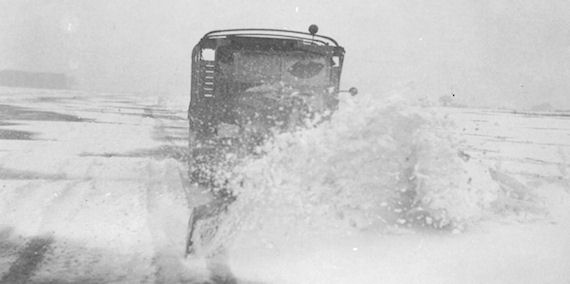
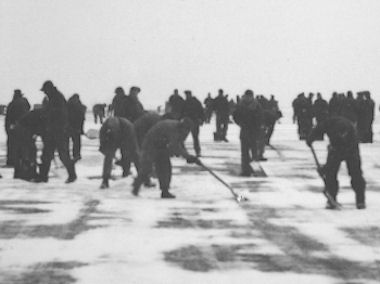
In the winter, it took a lot of hard work by ground crew personnel before the air crews could fly
On January 2?, 1945 after an exceptionally heavy snowfall, each squadron on the base had to send some men down to work with the Utilities crew and get the runways clean for a mission the next day. About 100 men worked until 2 o'clock in the morning and were well repaid when they saw the ships take off as scheduled next morning.
The telephone linemen of this outfit have also been having their share of work due to the uncooperative weather. Big chunks of ice have formed on many telephone wires, causing them to snap under the weight. However, no sooner is a line reported out of order, when a couple of the linemen are out on the job. At the moment, the telephone system on the base is functioning without complaint.
All the other departments seem to be running smoothly with the possible exception of the weather office. They are besieged with calls, blaming them for the rugged weather. They promise to do something about it, come next spring.
These are all jobs without glory, but jobs vitally necessary in the functioning of a highly specialized war-machine. The men are doing these jobs for a simple reason. They know that each day's work well done brings us all that much closer to ultimate victory and our ultimate objective, "home."
"SPORT NEWS"
'Tis a sad, sad tale, but it must be told. With a chance to gain a tie for first place, the 10th Station basketball team lost their big game to the 465 Sub-Depot. They went out the hard way, though, trailing by only 1 point at the half. One of our regulars was missing and it would be a hard job indeed to try to convince any of the boys that they couldn't beat the 465th in a future game. They'll have their chance for revenge and glory in the second half tournament that starts next month. If they don't beat the Sub-Depot then, they'll challenge them to a game of darts.
"You figure it out department"
If two wrongs don't make a right do two P.F.C. stripes make a man a Corporal? Anastas Panteck, of the Utilities Section, has been a Pfc for 9 months now and was more that just surprised when he saw the new list of ratings on the bulletin board. There it was, clear as a bottle of Rupperts, Anastas Panteck, promoted to rank of P.F.C. (temporary of course). He claims that this makes him a corporal, but he may be in for a surprise come pay day. Somebody must have had their channels crossed.
"Infantry Blues"
On January 26, 1945, 14 men from this outfit left for an Infantry Reinforcement Center. Most of these men were volunteers and some of them had had previous Infantry training. To each of these men who left from each of the men in the squadron they left behind, "Good Luck" and "Happy Hunting."
Also during the month was another call for donation of blood (Type O) to be sent to the boys on the fighting fronts. Out of a possible 110 enlisted men and officers eligible to donate there were 97 men of the unit who reported to the hospital to watch their red blood flow into the large-appearing pint bottles. Many remarks were passed around good-natured like that a pint for a shot of whiskey wasn't a fair bargain. However all the men who donated felt much better for doing so. It was the least they thought they could do for their fellow Americans on the fronts. It seemed as if the same men who donated the previous time were among the first in line on the opening day around the 15th and 16th of January. The men who didn't donate were either in the hospital doped up on sulfa drugs, on pass or furlough, or turned down by the medics. It was a good showing for the outfit.
About the next thing that happened was in favor of the heavy smokers of the outfit in that cigarette rations were increased from the five-pack-a-week plan to the old seven-pack plan.
Along towards the 29 of the month all the enlisted men in the squadron under the age of 31 were ordered to report to the hospital in order to take a physical examination for the Infantry Reinforcement Training Program. Most of the fellows reporting qualified with a few exceptions, mostly caused by defective vision or poor feet. Naturally the qualified and unqualified are sweating out the Infantry. Some desiring to go and other reluctant to leave their friends - which is understandable in that most of the boys have been together now for about two years. As yet all that has happened is just "sweating it out."
February 1945
Once again this has been a notable month inasmuch as it has seen another group of former 10th Stationites shed their air corps wings for the crossed rifles insignia of the Infantry. It seems that the War Department has heard about the prowess of these stout-hearted and broad-shouldered members of our outfit and has decided to put their excessive strength to a more rugged use. At the moment every physically fit man in our organization is sweating out the day when he, too, will learn through first-hand experience just how Jerry reacts when confronted by the talking end of an M1.
On the first part of February this station was honored by a visit from a War Manpower Board consisting of two Colonels and a Major. Their job was to see how many men on this base were doing jobs that could be done or handled by fewer men and to decrease or recommend a decrease in personnel of the station if necessary. The prevalent rumor at the time was that if they found anyone who was idle or with not enough work to keep him busy then there was a suitable candidate for Infantry Reinforcement Training with a rifle and the pack. During their three-day stay the daily attendance at the Red Cross Aero Club was practically non-existent. It was shortly after they left that the chosen few were picked for the Infantry. (The word "shanghaied" will be substituted upon request.) Many of the fellows that left had been with the 10th Station almost since the day the outfit was formed in Jacksonville, Florida, in April of 1943. There were some sad farewells, but war is like that all in all, the departing warriors left with a spirit of bravado saying they'd be seeing us back home, if not sooner, on the other side of the channel. Also at this time Sgt Robert "Bob" Cranshaw volunteered for Infantry OCS and left his buddies of the outfit. Bob was one of the few originals left since the date of activation. He figured that he could beat the draft and we all hope he makes the grade as an officer. It looks as if the outfit will be down to old men and "4-Fs" of the Army if the Infantry keeps calling.
Flying Control personnel were kept busier than they had been for some time. Getting the long-awaiting break in the weather during the latter part of the month, our Liberators were up almost continually. Watching the planes come back after a mission with empty bomb bays that only a few hours ago had rained tons of death on Germany is compensation enough for any extra work that had to be done.
Utilities Section, having lost four more men to that much talked-about outfit known as "the Infantry", has really been hard hit. However, in a few days replacements arrived in the form of a number of combat gunners, who had anywhere from 2 to 22 missions in over Hitler's terrain. They were put on Detached Service with Utilities for about a month. In addition, they were given a number of former ack-ack gunners to help them. Once again base utilities is at full strength and helping to keep this base a suitable place to live in and above all to help keep it operational.
News from the other departments is more or less static. Everyone is working just a little harder, trying to prove how essential he is to the Air Corps.
Extra-Curricular Activities
In spite of any dissenting thought to the contrary, the war can't last forever. With that the end in sight, our squadron has adopted a policy of Orientation lectures. The return to civilian life (Amen) will produce the inevitable economical and political issues and situations. We must know, as a whole and as individuals, just what we have gained and accomplished through these years of bloodshed.
We must be prepared to handle any forthcoming problems but this can be done only by knowing what brought us those problems and what lies behind them. With these ends in mind, Lt Keusdat [exact spelling unsure] of Station S-2 gave a short lecture at our first orientation meeting. This was followed by a talk by Lt O'Neill, also of Station S-2, who gave us a very graphic play-by-play account on the war, effusive on all fronts. Following these offensives on maps that cover the face of the earth, helps one realize a bit more the vastness and intrigues of a world-wide struggle. It's quite a big job, but we're the guys who can do it.
The following week we were treated to a model briefing at the Station S-2 briefing room. Target for the day of the model briefing was Hanover and the actual briefing as it had been given to the combat crews a few months previously was depicted in its entirely. It is hard to realize the intricacies of such an operation until you sit in on one of these sessions. There are reports from different officers covering all factors that need to be known to make the mission successful. Target area, primary and secondary, flak and fighter areas, weather all along the route and many other things of importance.
The highlight of this meeting, however, was an impromptu talk by Lt Walker, [1/Lt Joseph R. Walker, 578th Sqdn] a pilot who had completed 32 missions. Lt Walker told in a most amusing manner about some of his experiences over Adolph's crumbling domain and about some of his narrow escapes from Jerry flak and fighters. He also said he'd be glad to take anyone who cared to go up with him on his last mission. It's a lucky thing for somebody that his last statement was made in jest. At the moment, Lt Walker is missing in action on his 34th mission.
These orientation lectures should prove interesting and beneficial in many ways. However, if nothing else, it keeps us out of that fatal poker game for an hour or more.
Sports
Stand up and cheer for the basketball seasons, all teams on the base have been trying to beat the 465th Sub-Depot who had an ETO-winning streak of about 20 straight games. They won the championship last year and also the first half of this year's tournament. However, perseverance and some sharp shooting finally won out, as the 10th Station whipped them. On the memorable night of the grand championship we beat them. We now lead […missing a line on the microfilm…] winning the championship playoff game from the Sub-Depot, will satisfy the courtesans and their cohorts of the 10th Station.
Short-Changing the Army
Oh, you can't beat the Army out of anything! They'll get you at every turn. Maybe so, but not in February. With a feeling of supreme triumph, the Squadron lined up for pay call on the 28th. Happy grins were in abundance, and why not: For only 28 days of work and here we were getting a full pay as if we'd put in the usual 30 or 31 days. Now if we could only do away with Leap Year.
Cheers till next month.
March 1945
Comes now the monthly installment to the history of the 10th Station. Seems like each month rolls along over here as fast as the installment collectors hit the boys around the first of each month back home.
In line with its policy of taking only the stout-hearted and bravest men to the Infantry, the War Department decided that they needed 15 more men from the 10th to help the boys across the Rhine so again 15 more men shed their Air Corps piping for that of the Infantry. Each and every call is being felt more and more by the unit as the old fellows leave it for the new Infantry. Men all together over two and a half or three years, and most of that overseas, are being called up now. It is kinda hard to see a fellow that has been over here for 30, 31, 32 or more months have to leave for the trenches. But, the fellows leave and the war still goes on its merry way.
In all, March was a fairly active month in that something or another was always brewing. It was with all of that sort of stuff happening that made the month go by faster.
In the first week of the month the station was more or less honored with a visit from the Air Inspector back in Washington, DC. A mad scramble was made by all units to outdo each other in the inspection report that would follow. The station, as a whole, was really in fine shape but naturally the 10t1h stood out like a beacon light. It shined with little or no recognition, however. The area and barracks were in perfect shape (so thought the First Sergeant and Commanding Officer anyhow). It will have to be admitted though that the old stamping grounds looked in darn good shape.
About the next occurrence in the curriculum of the month was a party held at the NCO Club for the unit. It was a humdinger, with plenty of beer and for the first time since its inauguration, more women present than G.I.s. The guys really got on the old ball, though, and some of the boys were mighty embarrassed when to their amazement two or more of their various lady friends made their presence known at the same time. At any rate, even the extra girls had a pretty good time and the men said that it was the best party yet of the 10 or more that have been held.
Also during the month the unit changed Commanding Officers with Major Elisha R. Daughtrey going back to the good old U.S.A. on an emergency rotation plan. Captain Franklin W. Dawson assumed command upon the Major's leaving and already the outfit has noticed the difference. It was a fortunate break for the Major and it was agreed that some of the men would want to go back to their homes under the same conditions as he. Captain Dawson also assumed the duties as Station Administrative Inspector upon the change, it being a 2nd Air Division policy that the complement squadron commander also be the Station Administrative Inspector.
About the next thing was the blossoming arrival of a group of new men from the good old USA. It was very interesting for the old veterans of the outfit to listen to the running commentary on the ETO by the new men. A few good old Army bitching sessions immediately cropped up with the new men adding newer angles on the old song-and-dance routine. At least it was felt by the 10th that it now has the champion griper of the ETO in one of the new arrivals. Their arrival was celebrated by a strafe job from a Jerry plane on our airdrome that same evening. Naturally the older men told them it was a nightly occurrence and some of them were really worried about their future hours of sleep being interrupted each evening. Numbers of "Red" and "Black" alerts were broadcast during the period of March. This time March winds blew in "Jerry" nuisance raiders instead of April showers.
In addition to many of the new men from the states a few old Infantry hands have been transferred to the 10th Station. In all there have been a decided number of new faces appear and old faces disappear during the month.
With the new arrivals and Infantry shipments going out the Orderly Room has definitely been on the beam jumping around making new rosters and other records pertaining to transfers. And also with the change in Commanding Officers the boys are really on the ball. Precaution more than anything else helps them to tend to be that way.
Flying Control has really been putting out a great deal of work this month. Getting missions off practically every day makes them hop, skip, and jump. The personnel enjoy that, however, because each successful mission is a mission that much closer to ultimate victory and the return to the blue serge we all want so bad. Anyway we all hope so.
The rest of the departments are still plugging along the same as far as possible and getting their own little individual part done towards putting the awkward-looking Libs into the air and over Hitler's failing fortress of Europe.
S/Sgt "Andy" Andrews surprised all the men this month with a new wool sweater issue. Andy being the Supply Sergeant came up with some new items just in time as the men were beginning to give him the raspberries and hoping for a new dealer in the Supply line.
M/Sgt "Vic" Vickers the base electrician was placed on Detached Service to North Pickenham this month to help them set up their "fancy" lighting system on the runways. Vic did a good job on the ones here and they wanted him to work on theirs using his own system of installation which was so successful here. It is a good deal and a change for Vic and when he returns his boys will be waiting for him. Waiting with three new men. One from the Infantry and two from the states. So instead of the old staff of three all totaled he now has six.
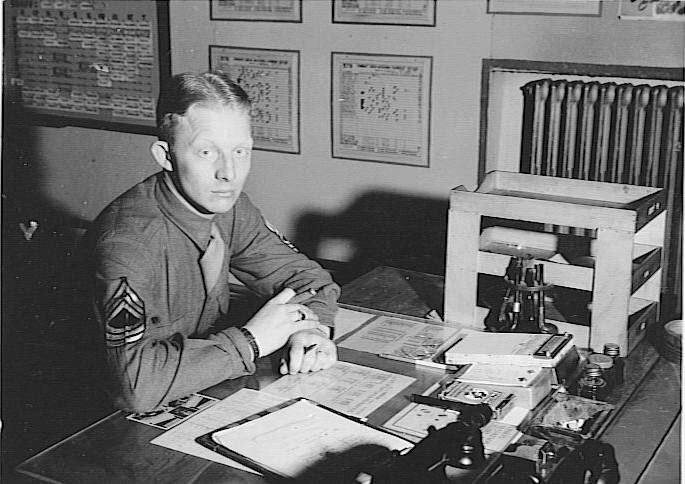
The highlight of the sport news of the month was the big game for the championship between the 10th Station "hoopsters" and the 465th Sub-Depot men. It turned into a very interesting game with Jack O'Brian high scorer on our team. The final score was 37 to 32 in favor of the Sub-Depot. It was hard to lose the championship but to lose it after a fight like that made the boys feel pretty good in that the best team won. We had hoped to bring the cup home to roost this year but fate decided different. It looks like the 10th's hoopsters are getting ETO happy quicker than the hoopsters of the 465th Sub-Depot.
Cpl. Johnny Reagan got his wish to see the Continent in that he was placed on Detached Service to the Continent someplace to work on radios etc. He will have plenty of stories to tell on his return, no doubt. Especially about the French girls.
Most of the old men of the outfit signed up for the proposed trip to Paris on a 48-hour pass, but only a lucky six went out of the drawing as winners. As only six men were eligible to go out of the squadron the names were drawn from a hat. At least some of the outfit will be able to tell the difference now between France and the rest of the world.
Well, more next month and we hope it will be the end of the war.
April 1945
As far as the 10th Station for the month of April is concerned it really never had an opportunity to function because on the 15th of the month it was disbanded under the provisions contained in General Orders #52, HQ 8th Air force dated 12 April 1945.
The majority of personnel of the 10th were transferred per paragraph 8 Special Orders #54, HQ 392nd bombardment Group (H) to the 403rd Headquarters and Base Services Squadron. It appeared that the 10th was the nucleus for the new Headquarters Squadron and the fellows would stay on their same jobs as before.
Most of the men welcomed the change in that possibly they would be able to fill some T O vacancy. But the rank was over in many cases so consequently nothing in the line of promotions for enlisted men could be seen but as usual there is a chance for some of the officers to gain well-earned promotions.
Up to the 15th of the month the men of the 10th under the guidance of Lt Fish were doing a fine job of preparing a good softball team. They will have to work it out under the new outfit now but the old 10th will carry on in spirit because it will be the warriors of the 10th that will win for the 403rd.
For the information of future readers the following dope is printed regarding the 10th prior to and up to overseas shipment.
Supplement to 10th Station History
It is not generally remembered that the 10th Station personnel did not ship out of Camp Kilmer in full strength. Due to shortage of available shipping space, four officers and seven EM were left behind, but in spite of all our misguided hopes and prayers, this arrangement was only temporary. One week after the rest of the outfit left, the 7 EM, with S/Sgt Boyer in charge, were herded into a G.I. truck and headed for the Staten Island pier. When we arrived, there were 5 Red Cross volunteers at the dock, graciously serving lemonade and doughnuts and after about half an hour of heroically-accepted condolences, we made ready for the fatal 40 steps up the gangplank. The boat was quite empty and lonesome when we boarded, but in about one hour, things were quite to the contrary. A battalion of Army engineers were to be our shipmates for this memorable voyage and soon they made their presence known. The seven of us had grabbed the first stateroom we came across, but it seems that someone though a room about 6' x 9' was much too large for seven men. Five of the engineers were immediately attached to our room for rations, quarters and anything else of interest to them that we had. Just outside our room was a piano and for 16 nights running, someone was always trying to find out why it wouldn't play the right tune.
In spite of all discomforts the boat got underway about midnight 15 June. When we awoke the next morning we were just about in the middle of a convoy of 100 other ships, which was a comfortable feeling to all of us.
The first week was spent in hatching some wild rumors about what might happen to us the second week. In between we managed, by sheer ingenuity, to get in about 8 hours of poker a day.
On the twelfth night, just as Shakespeare anticipated, we had our first taste of action. We had disbanded our convoy the previous afternoon and were not sailing all alone. It was about 2300 hours when we saw flares in the distance. At first, we thought that it was from land in the distance, but when the order came for all hands to go below deck and stand by with helmets and carbine, we knew that if were near land, it must be German-held. An invasion of German-held territory hardly appealed to us at the moment, all the less so because we had no ammunition for our carbines. The ammunition had been collected and stored before we started and brave men that we were, we realized that rifle butts would be a bit insufficient in this crisis.
There were some 200-odd men, standing and sweating below decks with helmets on and empty weapons, listening to a terrific bombardment outside. Some volunteered to go out on deck and throw their rifles at any enemy planes that might come low enough, but the ship's captain, not being sure of the men's aim, had to reject their offer.
After about 2 hours, all noise subsided and we were told we could get some sleep. Rumor had it that the convoy we had left had been attacked but never having gotten any official verification, it will have to remain a rumor. Nevertheless, there wasn't much sleep to be had that night. It's quite different than sleeping in a nice warm barrack bed. It is awfully difficult to sleep and listen for enemy fire at the same time.
Next morning, we were all alone, surrounded only by endless mountains of water and our thoughts. For the first time, we flew a barrage balloon overhead, and that in itself was good for a few rumors.
Without further incident we arrived in Wales at 0700 hours on 29 June. Dry land never looked so good, although we were later to learn that the land isn't usually so dry in England.
The engineers disembarked that morning but the seven of us had to spend another day on the ship. Next morning, we were taken by truck to the nearest railroad station from where we went on to AAF Station 115 at Shipdham. There we were reunited with our outfit and split into 2 groups, one of which stayed at Station 115 and the other which went to AAF Station 118 at Wendling. Eventually both groups were coordinated at Station 118 in Wendling and the usual fantastic yarns of their experiences at sea started making the rounds. It's amazing to note that in spite of all the hardships endured, not one of the outfit was even a minor casualty. Imagination is a wonderful thing.
As part of the closing of the history of the 10th Station Complement Squadron the following excerpt of one of the men is printed to show the feeling of loyalty and unity the men of the outfit had and that good old never-say-die spirit of American patriotism. This fellow was a plane guard on the memorable night of 5 June 1944 when the boys were on their way to hitting the Normandy beach the next early morning - "D" Day, 6 June 1944.
Supplement to June 1944 10th Station Complement Squadron History
Probably the third most important date that will be remembered in connection with World War 2 is 6 June 1944, the other two being of course 7 December 1941 and the great day of peace to come.
I was on plane guard on the night of the 5th of June and although I've never enjoyed pulling guard duty, I'm glad that I was picked for that detail on that particular night. We hadn't been told, but as is usually the case, you can feel when the "big" thing is at hand.
The crew gunners came out to their ships from briefing at about midnight, knowing fully well that this was the mission. They checked, double-checked and then rechecked again all armament and other necessary equipment. About 0200 hours the ships' Officers, pilots, co-pilots, navigators and bombardiers came out. Each man had that certain tenseness about him, that extra something that showed that this was not just 'another one'. Finally all crew members got into their ships. Motors purred then vibrated to a deafening crescendo. At 0300 hours the first ship started down the runway. At assigned intervals one after another seemingly flapped its wings in the night and headed for the dark uninviting skies above.
There they were, going to join the mighty air armada that was to cover the greatest landing feat in the history of warfare. For months, they had been dropping tons of havoc in preparation for this day. Many of the airmen were up there doing their best to provide a cover for their brothers and friends that might be below.
Stories of the invasion will be reread and retold for years and years to come, but nothing will ever erase that thrill, as I stood there that night, watching, praying, that those big planes, whose bomb bays would soon be opening on their greatest endeavor, would save the lives of countless of my unknown buddies in khaki.
FINAL CHAPTER
Coincidental, and tragically such, that our own 10th Station Complement Squadron should be deactivated so closely following our dear President's passing into immortality. Superstitious individuals can now rely further in their beliefs as to the dire things that can occur whenever a "Friday the 13th" rolls around. It was on the fateful day, Friday the 13th of April 1945 that most of us awoke to the dreadfully sad news of Franklin D. Roosevelt's death. The business of war rolled merrily along as usual, but with sadness in the hearts of every American and Ally partaking in bringing this blot on civilization to an end. Without a shadow of doubt, each and every G.I. will rank our President's name with all the other immortally great Americans that our country has given birth to. A great man has been cheated out of a great day, the forthcoming day of Victory. Somewhere, somehow, he, Franklin Delano Roosevelt, will know of this day and he will smile contentedly and rest in peace.
The 10th is dead, but in name only. Long live the successor, the 403rd Hq & Base Services Sq., ASG.
